RMIT: HRM's Impact on Organisational Success Through the AHRI Model
VerifiedAdded on 2023/06/12
|12
|3265
|363
Essay
AI Summary
This essay examines the contribution of Human Resource Management (HRM) to an organization's effectiveness, utilizing the Australian Human Resources Institute (AHRI) Model of Excellence as a framework. It begins by highlighting the increasing importance of HRM as a source of competitive advantage and the evolving roles and skills of HR professionals. The essay reviews literature emphasizing the strategic role of HRM, its impact on organizational performance, and the need for innovative approaches to managing human resources in a globalized environment. It discusses organizational effectiveness in terms of achieving objectives with minimal resources and explores the competencies required for multi-skilled human resources. Examples from ASDA and Sainsbury's are used to illustrate different HR policies and their impact. The essay concludes by emphasizing the importance of aligning HR strategies with business objectives and the need for HR professionals to understand the business environment and drive cultural change to support organizational success. Desklib provides access to this essay and a wealth of other study resources for students.
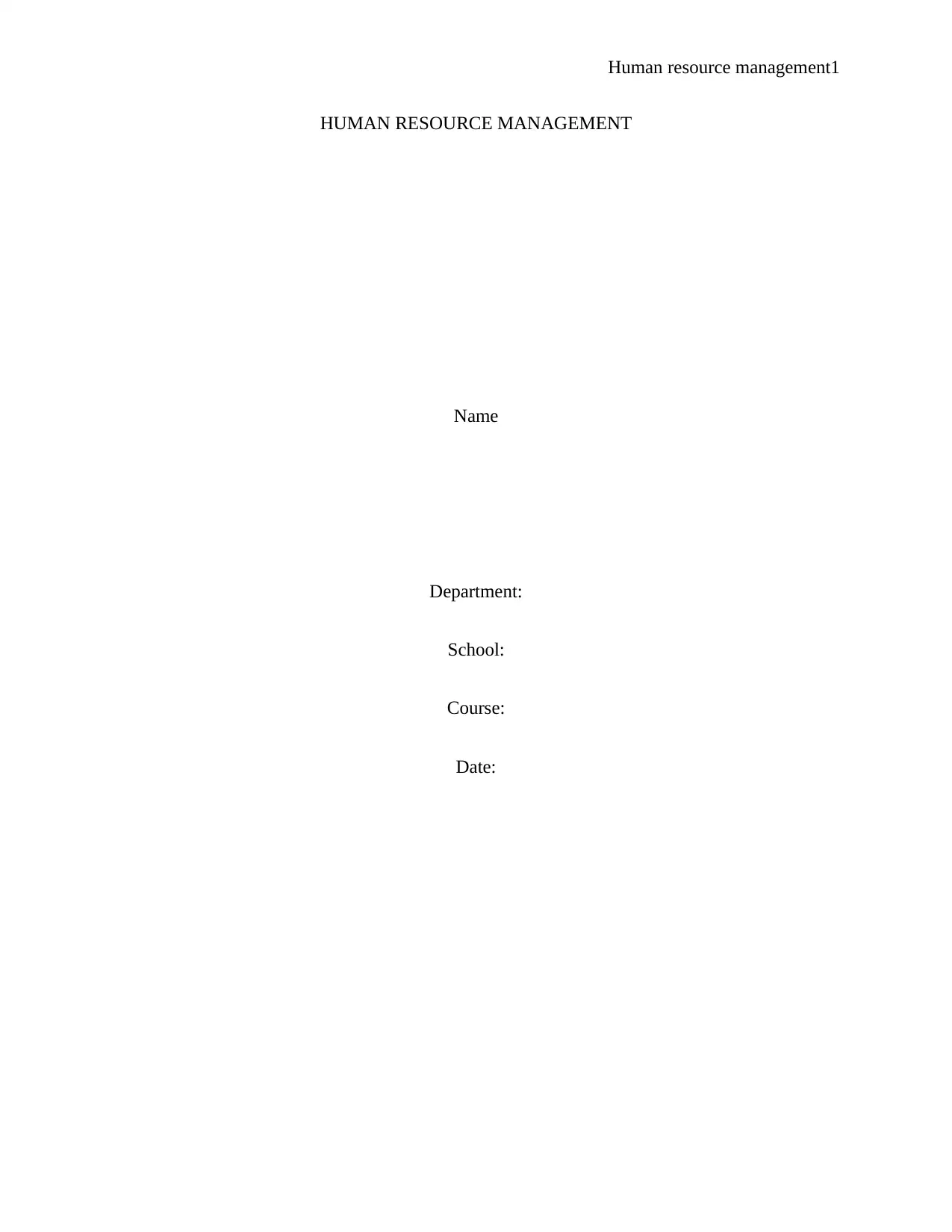
Human resource management1
HUMAN RESOURCE MANAGEMENT
Name
Department:
School:
Course:
Date:
HUMAN RESOURCE MANAGEMENT
Name
Department:
School:
Course:
Date:
Paraphrase This Document
Need a fresh take? Get an instant paraphrase of this document with our AI Paraphraser
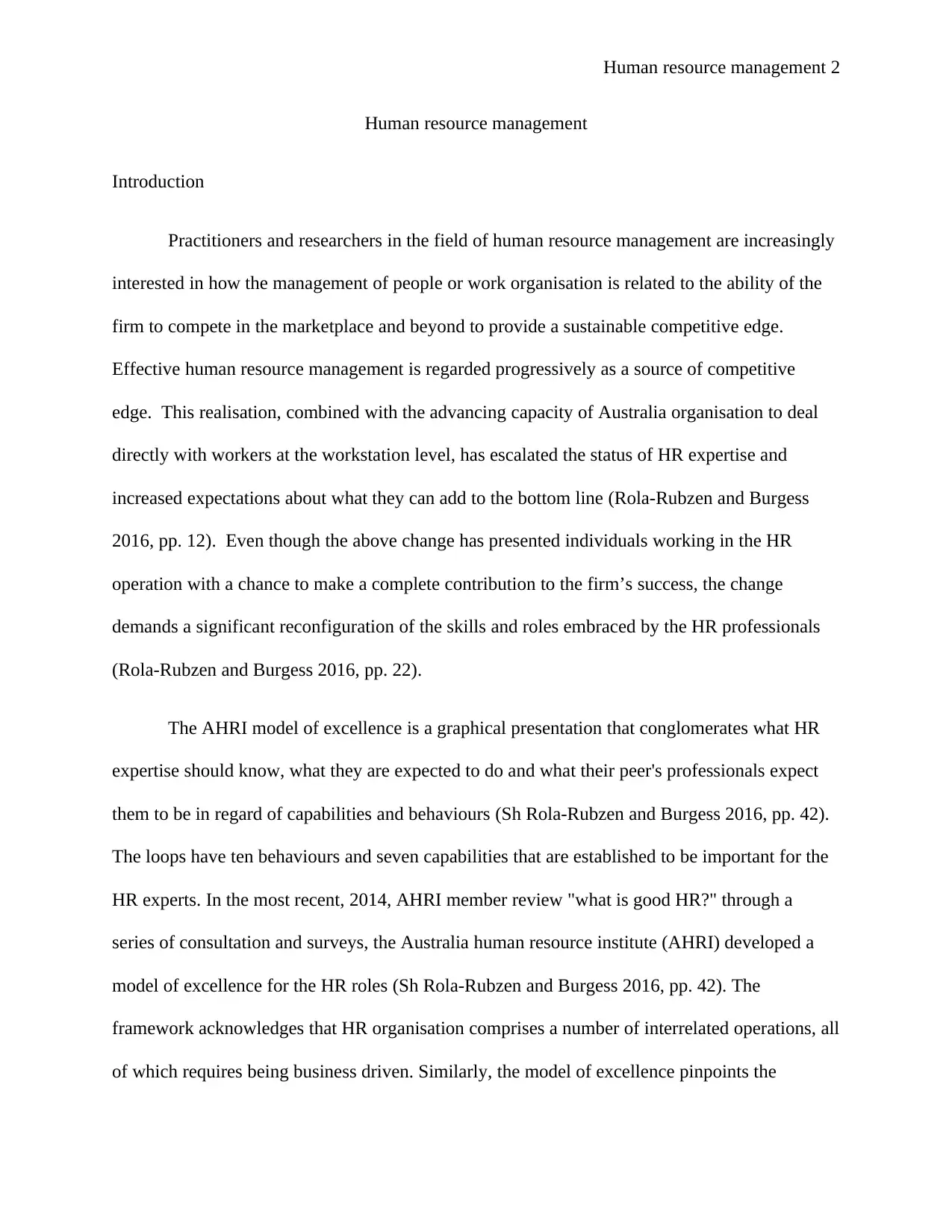
Human resource management 2
Human resource management
Introduction
Practitioners and researchers in the field of human resource management are increasingly
interested in how the management of people or work organisation is related to the ability of the
firm to compete in the marketplace and beyond to provide a sustainable competitive edge.
Effective human resource management is regarded progressively as a source of competitive
edge. This realisation, combined with the advancing capacity of Australia organisation to deal
directly with workers at the workstation level, has escalated the status of HR expertise and
increased expectations about what they can add to the bottom line (Rola-Rubzen and Burgess
2016, pp. 12). Even though the above change has presented individuals working in the HR
operation with a chance to make a complete contribution to the firm’s success, the change
demands a significant reconfiguration of the skills and roles embraced by the HR professionals
(Rola-Rubzen and Burgess 2016, pp. 22).
The AHRI model of excellence is a graphical presentation that conglomerates what HR
expertise should know, what they are expected to do and what their peer's professionals expect
them to be in regard of capabilities and behaviours (Sh Rola-Rubzen and Burgess 2016, pp. 42).
The loops have ten behaviours and seven capabilities that are established to be important for the
HR experts. In the most recent, 2014, AHRI member review "what is good HR?" through a
series of consultation and surveys, the Australia human resource institute (AHRI) developed a
model of excellence for the HR roles (Sh Rola-Rubzen and Burgess 2016, pp. 42). The
framework acknowledges that HR organisation comprises a number of interrelated operations, all
of which requires being business driven. Similarly, the model of excellence pinpoints the
Human resource management
Introduction
Practitioners and researchers in the field of human resource management are increasingly
interested in how the management of people or work organisation is related to the ability of the
firm to compete in the marketplace and beyond to provide a sustainable competitive edge.
Effective human resource management is regarded progressively as a source of competitive
edge. This realisation, combined with the advancing capacity of Australia organisation to deal
directly with workers at the workstation level, has escalated the status of HR expertise and
increased expectations about what they can add to the bottom line (Rola-Rubzen and Burgess
2016, pp. 12). Even though the above change has presented individuals working in the HR
operation with a chance to make a complete contribution to the firm’s success, the change
demands a significant reconfiguration of the skills and roles embraced by the HR professionals
(Rola-Rubzen and Burgess 2016, pp. 22).
The AHRI model of excellence is a graphical presentation that conglomerates what HR
expertise should know, what they are expected to do and what their peer's professionals expect
them to be in regard of capabilities and behaviours (Sh Rola-Rubzen and Burgess 2016, pp. 42).
The loops have ten behaviours and seven capabilities that are established to be important for the
HR experts. In the most recent, 2014, AHRI member review "what is good HR?" through a
series of consultation and surveys, the Australia human resource institute (AHRI) developed a
model of excellence for the HR roles (Sh Rola-Rubzen and Burgess 2016, pp. 42). The
framework acknowledges that HR organisation comprises a number of interrelated operations, all
of which requires being business driven. Similarly, the model of excellence pinpoints the
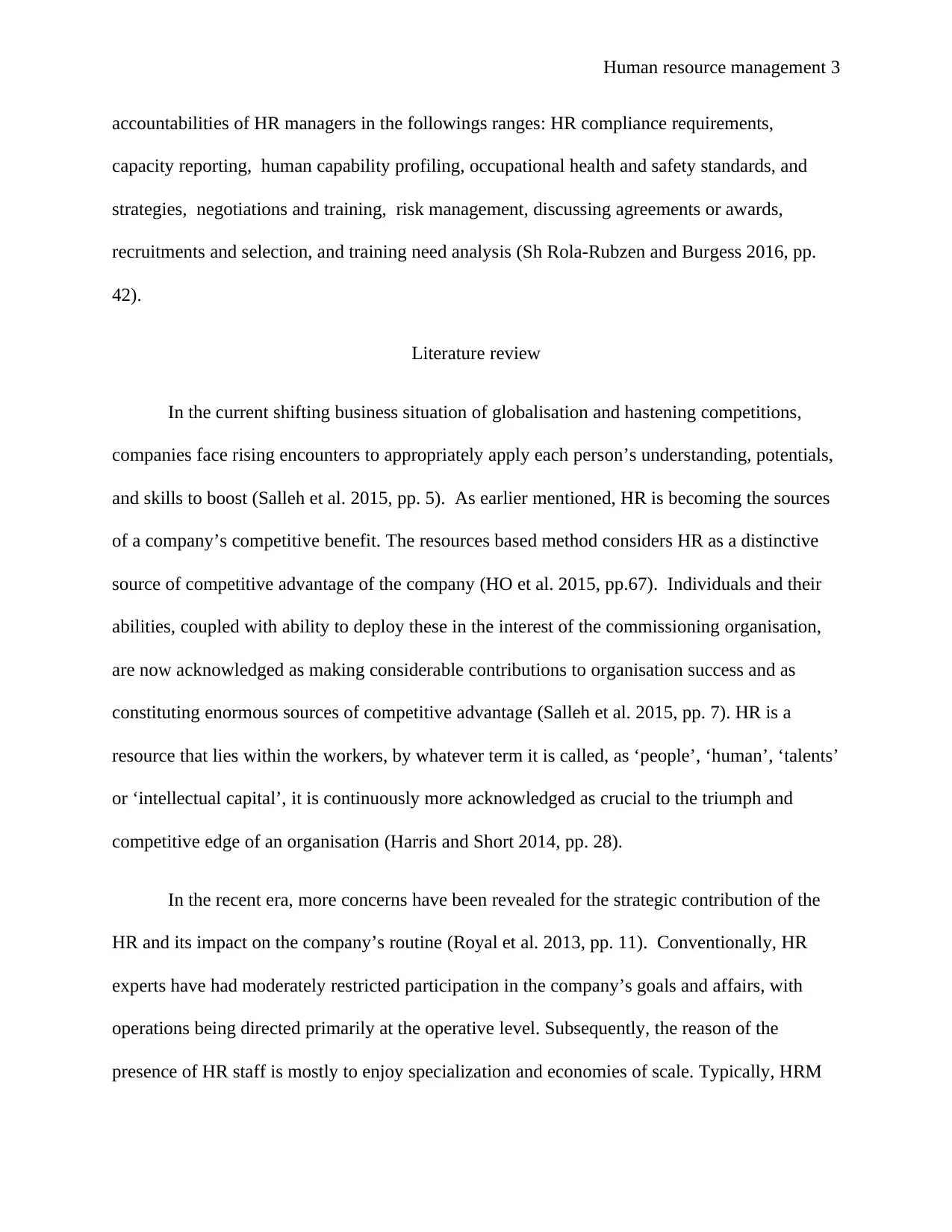
Human resource management 3
accountabilities of HR managers in the followings ranges: HR compliance requirements,
capacity reporting, human capability profiling, occupational health and safety standards, and
strategies, negotiations and training, risk management, discussing agreements or awards,
recruitments and selection, and training need analysis (Sh Rola-Rubzen and Burgess 2016, pp.
42).
Literature review
In the current shifting business situation of globalisation and hastening competitions,
companies face rising encounters to appropriately apply each person’s understanding, potentials,
and skills to boost (Salleh et al. 2015, pp. 5). As earlier mentioned, HR is becoming the sources
of a company’s competitive benefit. The resources based method considers HR as a distinctive
source of competitive advantage of the company (HO et al. 2015, pp.67). Individuals and their
abilities, coupled with ability to deploy these in the interest of the commissioning organisation,
are now acknowledged as making considerable contributions to organisation success and as
constituting enormous sources of competitive advantage (Salleh et al. 2015, pp. 7). HR is a
resource that lies within the workers, by whatever term it is called, as ‘people’, ‘human’, ‘talents’
or ‘intellectual capital’, it is continuously more acknowledged as crucial to the triumph and
competitive edge of an organisation (Harris and Short 2014, pp. 28).
In the recent era, more concerns have been revealed for the strategic contribution of the
HR and its impact on the company’s routine (Royal et al. 2013, pp. 11). Conventionally, HR
experts have had moderately restricted participation in the company’s goals and affairs, with
operations being directed primarily at the operative level. Subsequently, the reason of the
presence of HR staff is mostly to enjoy specialization and economies of scale. Typically, HRM
accountabilities of HR managers in the followings ranges: HR compliance requirements,
capacity reporting, human capability profiling, occupational health and safety standards, and
strategies, negotiations and training, risk management, discussing agreements or awards,
recruitments and selection, and training need analysis (Sh Rola-Rubzen and Burgess 2016, pp.
42).
Literature review
In the current shifting business situation of globalisation and hastening competitions,
companies face rising encounters to appropriately apply each person’s understanding, potentials,
and skills to boost (Salleh et al. 2015, pp. 5). As earlier mentioned, HR is becoming the sources
of a company’s competitive benefit. The resources based method considers HR as a distinctive
source of competitive advantage of the company (HO et al. 2015, pp.67). Individuals and their
abilities, coupled with ability to deploy these in the interest of the commissioning organisation,
are now acknowledged as making considerable contributions to organisation success and as
constituting enormous sources of competitive advantage (Salleh et al. 2015, pp. 7). HR is a
resource that lies within the workers, by whatever term it is called, as ‘people’, ‘human’, ‘talents’
or ‘intellectual capital’, it is continuously more acknowledged as crucial to the triumph and
competitive edge of an organisation (Harris and Short 2014, pp. 28).
In the recent era, more concerns have been revealed for the strategic contribution of the
HR and its impact on the company’s routine (Royal et al. 2013, pp. 11). Conventionally, HR
experts have had moderately restricted participation in the company’s goals and affairs, with
operations being directed primarily at the operative level. Subsequently, the reason of the
presence of HR staff is mostly to enjoy specialization and economies of scale. Typically, HRM
⊘ This is a preview!⊘
Do you want full access?
Subscribe today to unlock all pages.

Trusted by 1+ million students worldwide
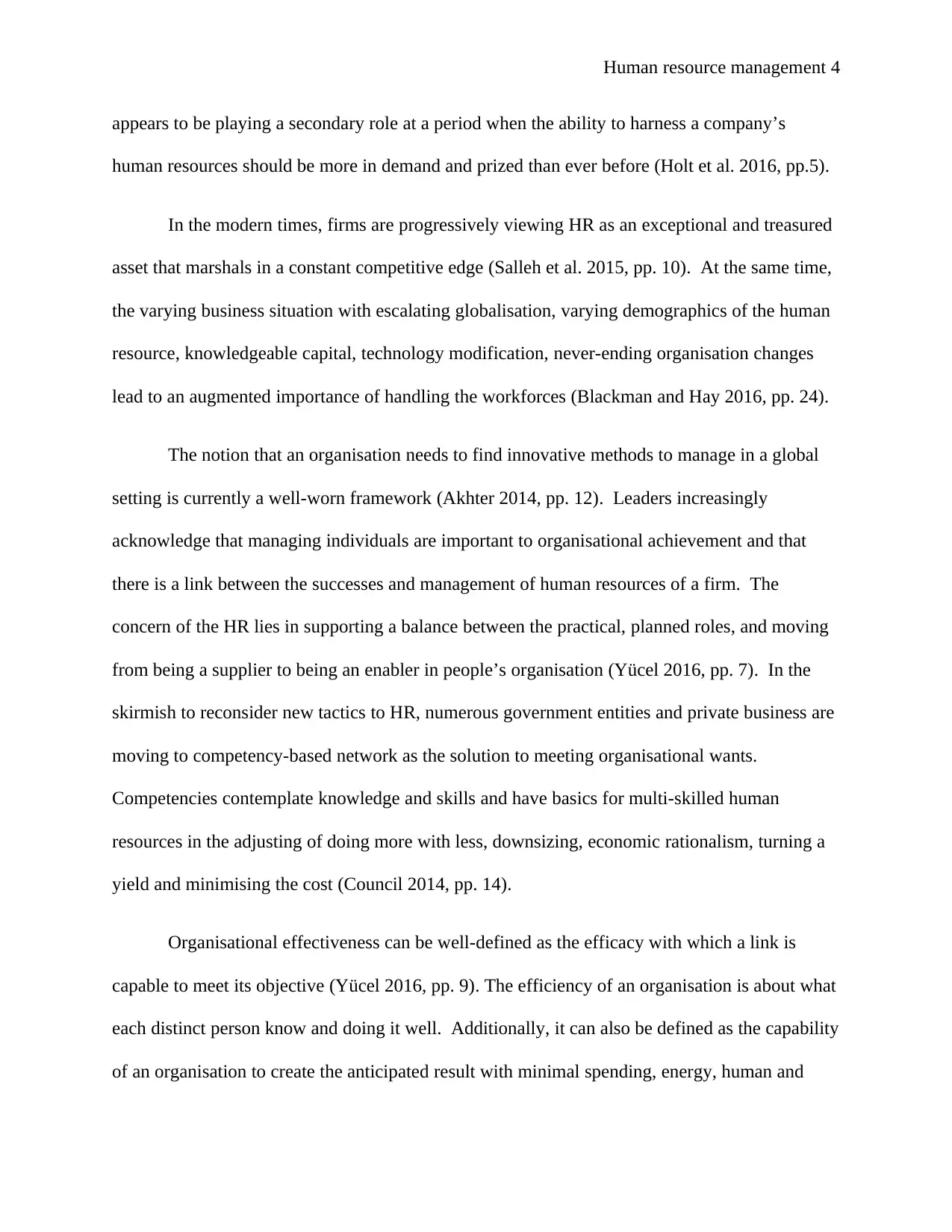
Human resource management 4
appears to be playing a secondary role at a period when the ability to harness a company’s
human resources should be more in demand and prized than ever before (Holt et al. 2016, pp.5).
In the modern times, firms are progressively viewing HR as an exceptional and treasured
asset that marshals in a constant competitive edge (Salleh et al. 2015, pp. 10). At the same time,
the varying business situation with escalating globalisation, varying demographics of the human
resource, knowledgeable capital, technology modification, never-ending organisation changes
lead to an augmented importance of handling the workforces (Blackman and Hay 2016, pp. 24).
The notion that an organisation needs to find innovative methods to manage in a global
setting is currently a well-worn framework (Akhter 2014, pp. 12). Leaders increasingly
acknowledge that managing individuals are important to organisational achievement and that
there is a link between the successes and management of human resources of a firm. The
concern of the HR lies in supporting a balance between the practical, planned roles, and moving
from being a supplier to being an enabler in people’s organisation (Yücel 2016, pp. 7). In the
skirmish to reconsider new tactics to HR, numerous government entities and private business are
moving to competency-based network as the solution to meeting organisational wants.
Competencies contemplate knowledge and skills and have basics for multi-skilled human
resources in the adjusting of doing more with less, downsizing, economic rationalism, turning a
yield and minimising the cost (Council 2014, pp. 14).
Organisational effectiveness can be well-defined as the efficacy with which a link is
capable to meet its objective (Yücel 2016, pp. 9). The efficiency of an organisation is about what
each distinct person know and doing it well. Additionally, it can also be defined as the capability
of an organisation to create the anticipated result with minimal spending, energy, human and
appears to be playing a secondary role at a period when the ability to harness a company’s
human resources should be more in demand and prized than ever before (Holt et al. 2016, pp.5).
In the modern times, firms are progressively viewing HR as an exceptional and treasured
asset that marshals in a constant competitive edge (Salleh et al. 2015, pp. 10). At the same time,
the varying business situation with escalating globalisation, varying demographics of the human
resource, knowledgeable capital, technology modification, never-ending organisation changes
lead to an augmented importance of handling the workforces (Blackman and Hay 2016, pp. 24).
The notion that an organisation needs to find innovative methods to manage in a global
setting is currently a well-worn framework (Akhter 2014, pp. 12). Leaders increasingly
acknowledge that managing individuals are important to organisational achievement and that
there is a link between the successes and management of human resources of a firm. The
concern of the HR lies in supporting a balance between the practical, planned roles, and moving
from being a supplier to being an enabler in people’s organisation (Yücel 2016, pp. 7). In the
skirmish to reconsider new tactics to HR, numerous government entities and private business are
moving to competency-based network as the solution to meeting organisational wants.
Competencies contemplate knowledge and skills and have basics for multi-skilled human
resources in the adjusting of doing more with less, downsizing, economic rationalism, turning a
yield and minimising the cost (Council 2014, pp. 14).
Organisational effectiveness can be well-defined as the efficacy with which a link is
capable to meet its objective (Yücel 2016, pp. 9). The efficiency of an organisation is about what
each distinct person know and doing it well. Additionally, it can also be defined as the capability
of an organisation to create the anticipated result with minimal spending, energy, human and
Paraphrase This Document
Need a fresh take? Get an instant paraphrase of this document with our AI Paraphraser
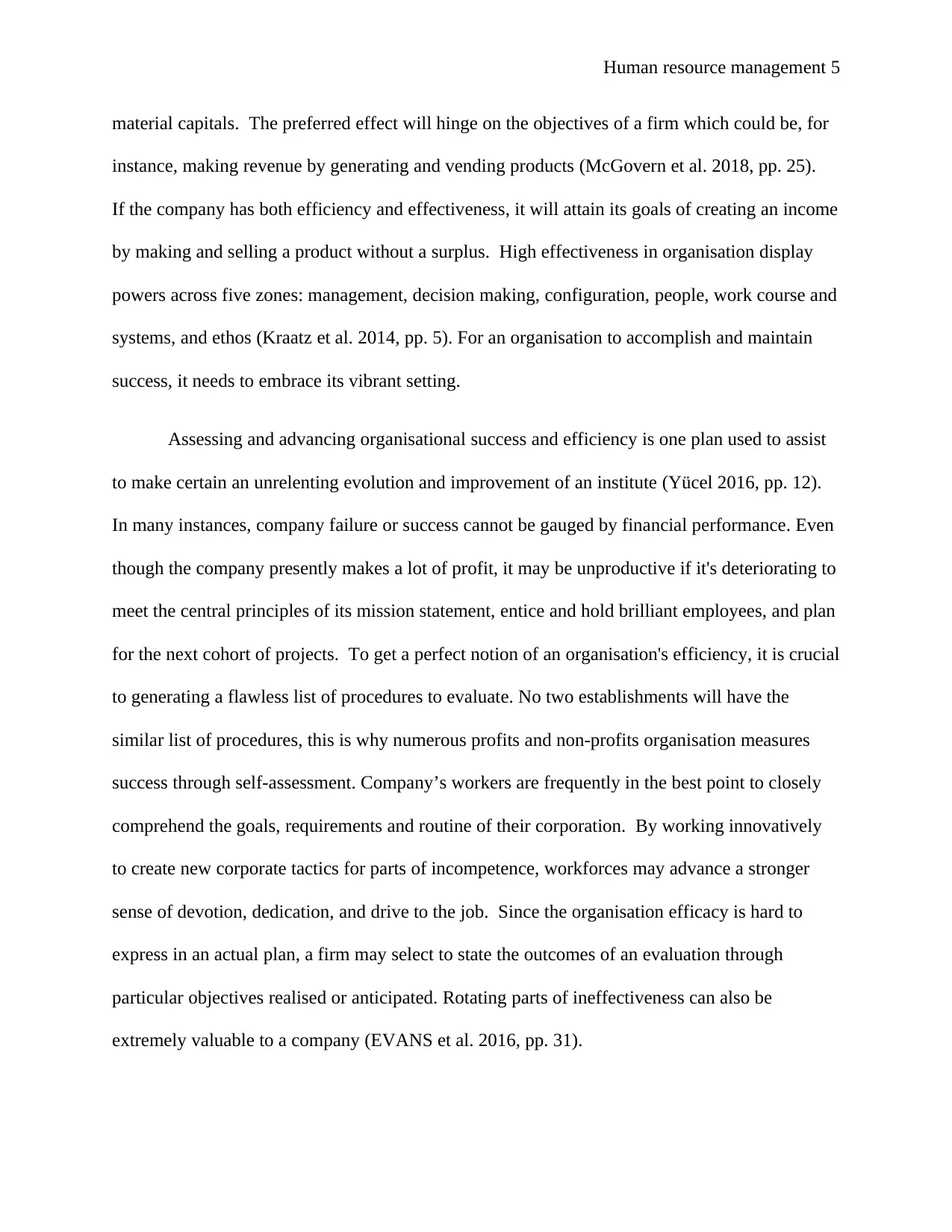
Human resource management 5
material capitals. The preferred effect will hinge on the objectives of a firm which could be, for
instance, making revenue by generating and vending products (McGovern et al. 2018, pp. 25).
If the company has both efficiency and effectiveness, it will attain its goals of creating an income
by making and selling a product without a surplus. High effectiveness in organisation display
powers across five zones: management, decision making, configuration, people, work course and
systems, and ethos (Kraatz et al. 2014, pp. 5). For an organisation to accomplish and maintain
success, it needs to embrace its vibrant setting.
Assessing and advancing organisational success and efficiency is one plan used to assist
to make certain an unrelenting evolution and improvement of an institute (Yücel 2016, pp. 12).
In many instances, company failure or success cannot be gauged by financial performance. Even
though the company presently makes a lot of profit, it may be unproductive if it's deteriorating to
meet the central principles of its mission statement, entice and hold brilliant employees, and plan
for the next cohort of projects. To get a perfect notion of an organisation's efficiency, it is crucial
to generating a flawless list of procedures to evaluate. No two establishments will have the
similar list of procedures, this is why numerous profits and non-profits organisation measures
success through self-assessment. Company’s workers are frequently in the best point to closely
comprehend the goals, requirements and routine of their corporation. By working innovatively
to create new corporate tactics for parts of incompetence, workforces may advance a stronger
sense of devotion, dedication, and drive to the job. Since the organisation efficacy is hard to
express in an actual plan, a firm may select to state the outcomes of an evaluation through
particular objectives realised or anticipated. Rotating parts of ineffectiveness can also be
extremely valuable to a company (EVANS et al. 2016, pp. 31).
material capitals. The preferred effect will hinge on the objectives of a firm which could be, for
instance, making revenue by generating and vending products (McGovern et al. 2018, pp. 25).
If the company has both efficiency and effectiveness, it will attain its goals of creating an income
by making and selling a product without a surplus. High effectiveness in organisation display
powers across five zones: management, decision making, configuration, people, work course and
systems, and ethos (Kraatz et al. 2014, pp. 5). For an organisation to accomplish and maintain
success, it needs to embrace its vibrant setting.
Assessing and advancing organisational success and efficiency is one plan used to assist
to make certain an unrelenting evolution and improvement of an institute (Yücel 2016, pp. 12).
In many instances, company failure or success cannot be gauged by financial performance. Even
though the company presently makes a lot of profit, it may be unproductive if it's deteriorating to
meet the central principles of its mission statement, entice and hold brilliant employees, and plan
for the next cohort of projects. To get a perfect notion of an organisation's efficiency, it is crucial
to generating a flawless list of procedures to evaluate. No two establishments will have the
similar list of procedures, this is why numerous profits and non-profits organisation measures
success through self-assessment. Company’s workers are frequently in the best point to closely
comprehend the goals, requirements and routine of their corporation. By working innovatively
to create new corporate tactics for parts of incompetence, workforces may advance a stronger
sense of devotion, dedication, and drive to the job. Since the organisation efficacy is hard to
express in an actual plan, a firm may select to state the outcomes of an evaluation through
particular objectives realised or anticipated. Rotating parts of ineffectiveness can also be
extremely valuable to a company (EVANS et al. 2016, pp. 31).
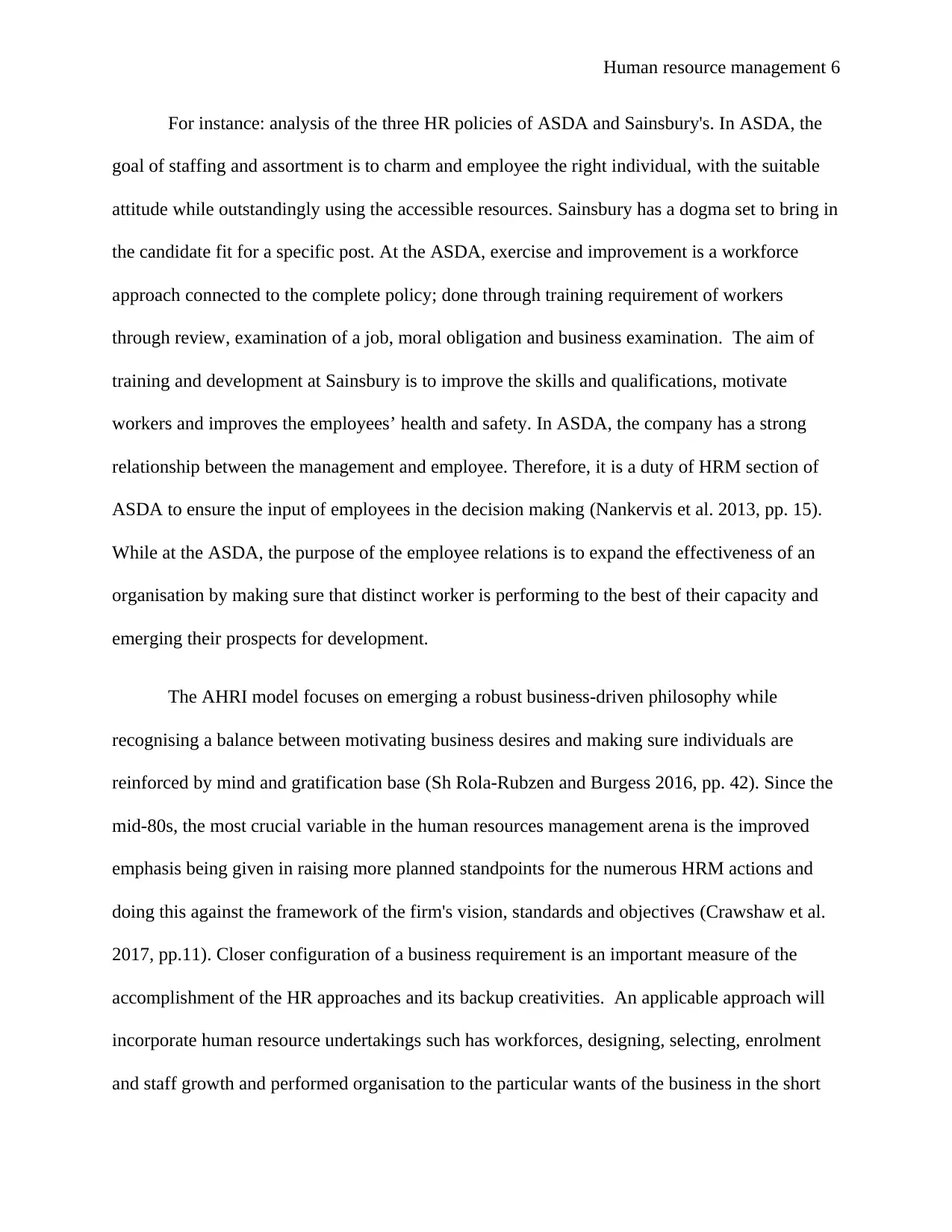
Human resource management 6
For instance: analysis of the three HR policies of ASDA and Sainsbury's. In ASDA, the
goal of staffing and assortment is to charm and employee the right individual, with the suitable
attitude while outstandingly using the accessible resources. Sainsbury has a dogma set to bring in
the candidate fit for a specific post. At the ASDA, exercise and improvement is a workforce
approach connected to the complete policy; done through training requirement of workers
through review, examination of a job, moral obligation and business examination. The aim of
training and development at Sainsbury is to improve the skills and qualifications, motivate
workers and improves the employees’ health and safety. In ASDA, the company has a strong
relationship between the management and employee. Therefore, it is a duty of HRM section of
ASDA to ensure the input of employees in the decision making (Nankervis et al. 2013, pp. 15).
While at the ASDA, the purpose of the employee relations is to expand the effectiveness of an
organisation by making sure that distinct worker is performing to the best of their capacity and
emerging their prospects for development.
The AHRI model focuses on emerging a robust business-driven philosophy while
recognising a balance between motivating business desires and making sure individuals are
reinforced by mind and gratification base (Sh Rola-Rubzen and Burgess 2016, pp. 42). Since the
mid-80s, the most crucial variable in the human resources management arena is the improved
emphasis being given in raising more planned standpoints for the numerous HRM actions and
doing this against the framework of the firm's vision, standards and objectives (Crawshaw et al.
2017, pp.11). Closer configuration of a business requirement is an important measure of the
accomplishment of the HR approaches and its backup creativities. An applicable approach will
incorporate human resource undertakings such has workforces, designing, selecting, enrolment
and staff growth and performed organisation to the particular wants of the business in the short
For instance: analysis of the three HR policies of ASDA and Sainsbury's. In ASDA, the
goal of staffing and assortment is to charm and employee the right individual, with the suitable
attitude while outstandingly using the accessible resources. Sainsbury has a dogma set to bring in
the candidate fit for a specific post. At the ASDA, exercise and improvement is a workforce
approach connected to the complete policy; done through training requirement of workers
through review, examination of a job, moral obligation and business examination. The aim of
training and development at Sainsbury is to improve the skills and qualifications, motivate
workers and improves the employees’ health and safety. In ASDA, the company has a strong
relationship between the management and employee. Therefore, it is a duty of HRM section of
ASDA to ensure the input of employees in the decision making (Nankervis et al. 2013, pp. 15).
While at the ASDA, the purpose of the employee relations is to expand the effectiveness of an
organisation by making sure that distinct worker is performing to the best of their capacity and
emerging their prospects for development.
The AHRI model focuses on emerging a robust business-driven philosophy while
recognising a balance between motivating business desires and making sure individuals are
reinforced by mind and gratification base (Sh Rola-Rubzen and Burgess 2016, pp. 42). Since the
mid-80s, the most crucial variable in the human resources management arena is the improved
emphasis being given in raising more planned standpoints for the numerous HRM actions and
doing this against the framework of the firm's vision, standards and objectives (Crawshaw et al.
2017, pp.11). Closer configuration of a business requirement is an important measure of the
accomplishment of the HR approaches and its backup creativities. An applicable approach will
incorporate human resource undertakings such has workforces, designing, selecting, enrolment
and staff growth and performed organisation to the particular wants of the business in the short
⊘ This is a preview!⊘
Do you want full access?
Subscribe today to unlock all pages.

Trusted by 1+ million students worldwide
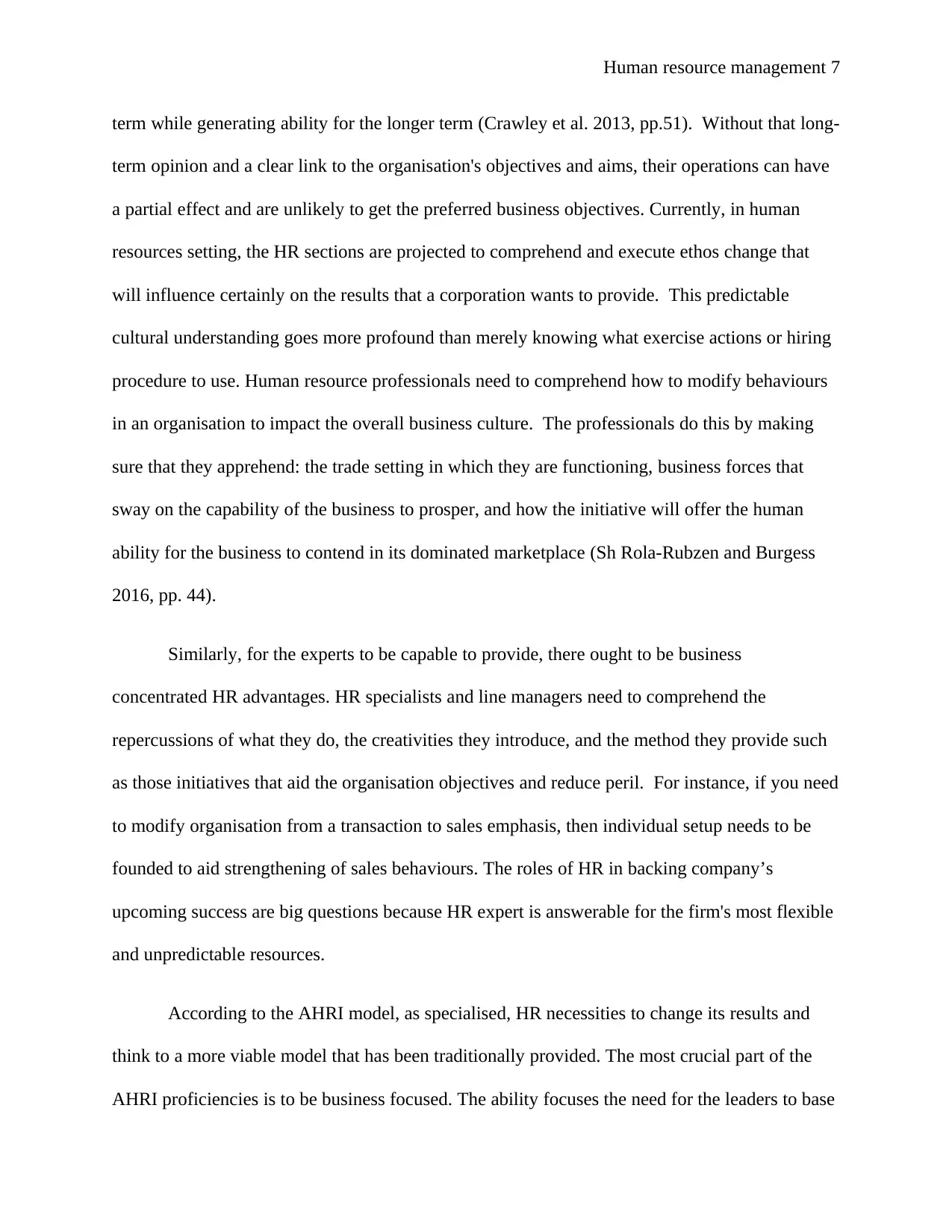
Human resource management 7
term while generating ability for the longer term (Crawley et al. 2013, pp.51). Without that long-
term opinion and a clear link to the organisation's objectives and aims, their operations can have
a partial effect and are unlikely to get the preferred business objectives. Currently, in human
resources setting, the HR sections are projected to comprehend and execute ethos change that
will influence certainly on the results that a corporation wants to provide. This predictable
cultural understanding goes more profound than merely knowing what exercise actions or hiring
procedure to use. Human resource professionals need to comprehend how to modify behaviours
in an organisation to impact the overall business culture. The professionals do this by making
sure that they apprehend: the trade setting in which they are functioning, business forces that
sway on the capability of the business to prosper, and how the initiative will offer the human
ability for the business to contend in its dominated marketplace (Sh Rola-Rubzen and Burgess
2016, pp. 44).
Similarly, for the experts to be capable to provide, there ought to be business
concentrated HR advantages. HR specialists and line managers need to comprehend the
repercussions of what they do, the creativities they introduce, and the method they provide such
as those initiatives that aid the organisation objectives and reduce peril. For instance, if you need
to modify organisation from a transaction to sales emphasis, then individual setup needs to be
founded to aid strengthening of sales behaviours. The roles of HR in backing company’s
upcoming success are big questions because HR expert is answerable for the firm's most flexible
and unpredictable resources.
According to the AHRI model, as specialised, HR necessities to change its results and
think to a more viable model that has been traditionally provided. The most crucial part of the
AHRI proficiencies is to be business focused. The ability focuses the need for the leaders to base
term while generating ability for the longer term (Crawley et al. 2013, pp.51). Without that long-
term opinion and a clear link to the organisation's objectives and aims, their operations can have
a partial effect and are unlikely to get the preferred business objectives. Currently, in human
resources setting, the HR sections are projected to comprehend and execute ethos change that
will influence certainly on the results that a corporation wants to provide. This predictable
cultural understanding goes more profound than merely knowing what exercise actions or hiring
procedure to use. Human resource professionals need to comprehend how to modify behaviours
in an organisation to impact the overall business culture. The professionals do this by making
sure that they apprehend: the trade setting in which they are functioning, business forces that
sway on the capability of the business to prosper, and how the initiative will offer the human
ability for the business to contend in its dominated marketplace (Sh Rola-Rubzen and Burgess
2016, pp. 44).
Similarly, for the experts to be capable to provide, there ought to be business
concentrated HR advantages. HR specialists and line managers need to comprehend the
repercussions of what they do, the creativities they introduce, and the method they provide such
as those initiatives that aid the organisation objectives and reduce peril. For instance, if you need
to modify organisation from a transaction to sales emphasis, then individual setup needs to be
founded to aid strengthening of sales behaviours. The roles of HR in backing company’s
upcoming success are big questions because HR expert is answerable for the firm's most flexible
and unpredictable resources.
According to the AHRI model, as specialised, HR necessities to change its results and
think to a more viable model that has been traditionally provided. The most crucial part of the
AHRI proficiencies is to be business focused. The ability focuses the need for the leaders to base
Paraphrase This Document
Need a fresh take? Get an instant paraphrase of this document with our AI Paraphraser
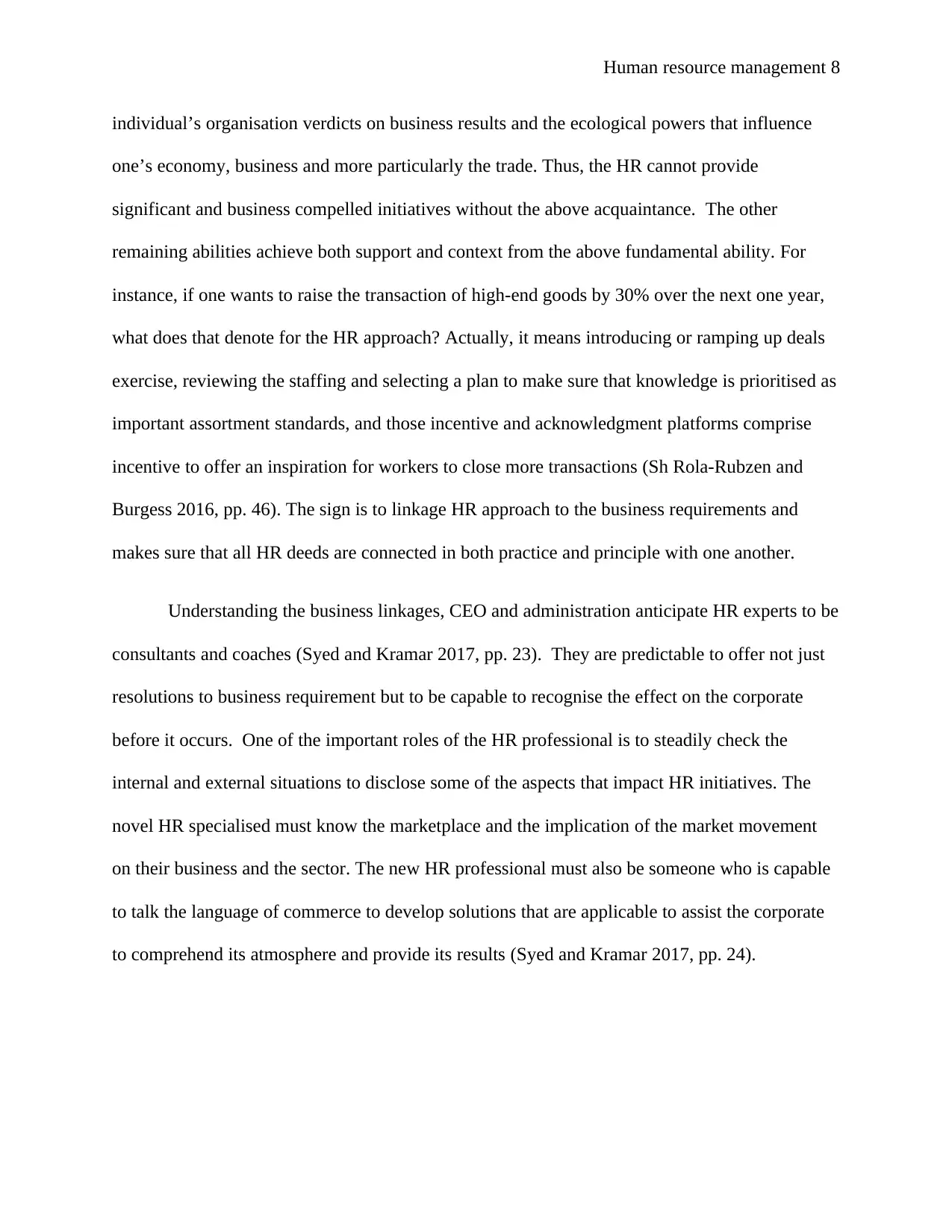
Human resource management 8
individual’s organisation verdicts on business results and the ecological powers that influence
one’s economy, business and more particularly the trade. Thus, the HR cannot provide
significant and business compelled initiatives without the above acquaintance. The other
remaining abilities achieve both support and context from the above fundamental ability. For
instance, if one wants to raise the transaction of high-end goods by 30% over the next one year,
what does that denote for the HR approach? Actually, it means introducing or ramping up deals
exercise, reviewing the staffing and selecting a plan to make sure that knowledge is prioritised as
important assortment standards, and those incentive and acknowledgment platforms comprise
incentive to offer an inspiration for workers to close more transactions (Sh Rola-Rubzen and
Burgess 2016, pp. 46). The sign is to linkage HR approach to the business requirements and
makes sure that all HR deeds are connected in both practice and principle with one another.
Understanding the business linkages, CEO and administration anticipate HR experts to be
consultants and coaches (Syed and Kramar 2017, pp. 23). They are predictable to offer not just
resolutions to business requirement but to be capable to recognise the effect on the corporate
before it occurs. One of the important roles of the HR professional is to steadily check the
internal and external situations to disclose some of the aspects that impact HR initiatives. The
novel HR specialised must know the marketplace and the implication of the market movement
on their business and the sector. The new HR professional must also be someone who is capable
to talk the language of commerce to develop solutions that are applicable to assist the corporate
to comprehend its atmosphere and provide its results (Syed and Kramar 2017, pp. 24).
individual’s organisation verdicts on business results and the ecological powers that influence
one’s economy, business and more particularly the trade. Thus, the HR cannot provide
significant and business compelled initiatives without the above acquaintance. The other
remaining abilities achieve both support and context from the above fundamental ability. For
instance, if one wants to raise the transaction of high-end goods by 30% over the next one year,
what does that denote for the HR approach? Actually, it means introducing or ramping up deals
exercise, reviewing the staffing and selecting a plan to make sure that knowledge is prioritised as
important assortment standards, and those incentive and acknowledgment platforms comprise
incentive to offer an inspiration for workers to close more transactions (Sh Rola-Rubzen and
Burgess 2016, pp. 46). The sign is to linkage HR approach to the business requirements and
makes sure that all HR deeds are connected in both practice and principle with one another.
Understanding the business linkages, CEO and administration anticipate HR experts to be
consultants and coaches (Syed and Kramar 2017, pp. 23). They are predictable to offer not just
resolutions to business requirement but to be capable to recognise the effect on the corporate
before it occurs. One of the important roles of the HR professional is to steadily check the
internal and external situations to disclose some of the aspects that impact HR initiatives. The
novel HR specialised must know the marketplace and the implication of the market movement
on their business and the sector. The new HR professional must also be someone who is capable
to talk the language of commerce to develop solutions that are applicable to assist the corporate
to comprehend its atmosphere and provide its results (Syed and Kramar 2017, pp. 24).
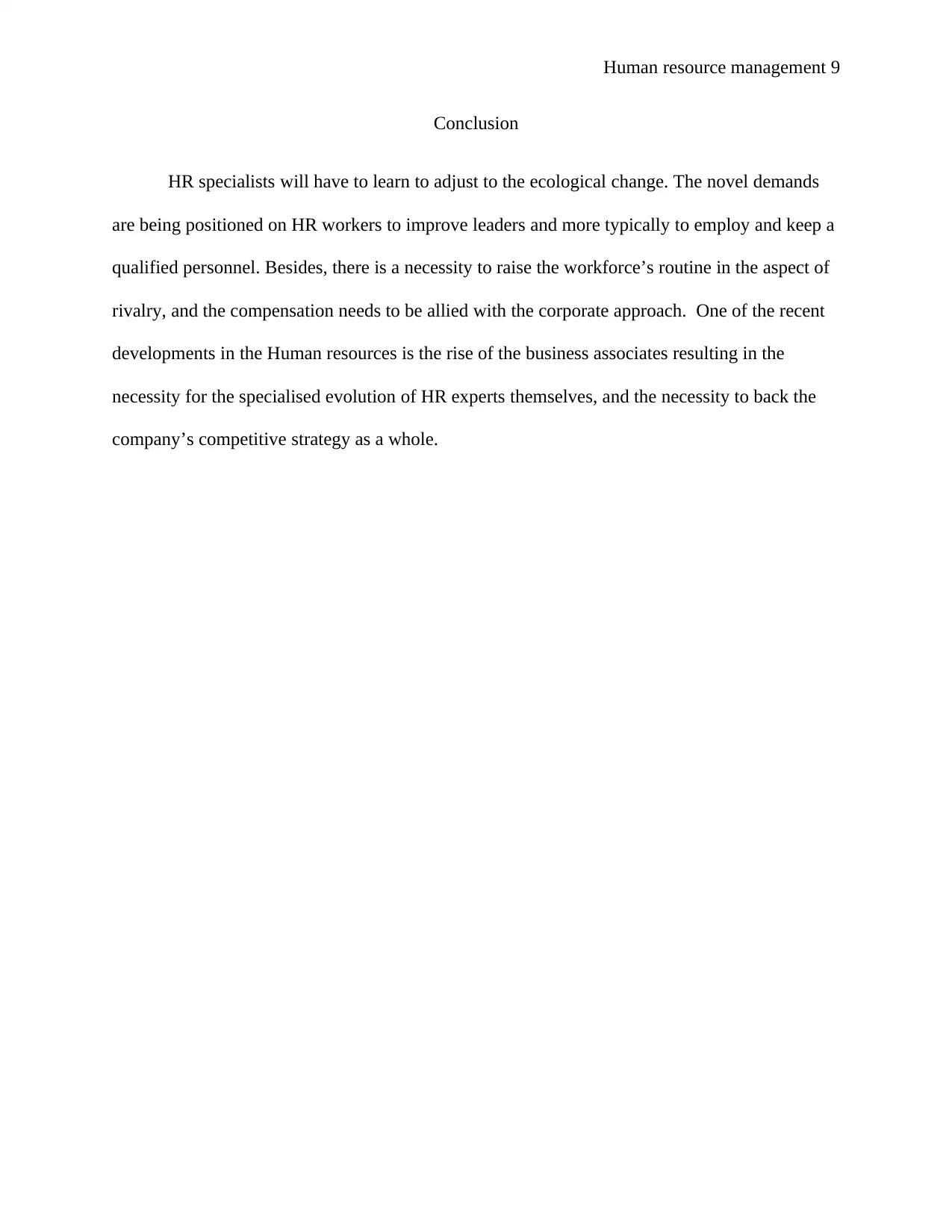
Human resource management 9
Conclusion
HR specialists will have to learn to adjust to the ecological change. The novel demands
are being positioned on HR workers to improve leaders and more typically to employ and keep a
qualified personnel. Besides, there is a necessity to raise the workforce’s routine in the aspect of
rivalry, and the compensation needs to be allied with the corporate approach. One of the recent
developments in the Human resources is the rise of the business associates resulting in the
necessity for the specialised evolution of HR experts themselves, and the necessity to back the
company’s competitive strategy as a whole.
Conclusion
HR specialists will have to learn to adjust to the ecological change. The novel demands
are being positioned on HR workers to improve leaders and more typically to employ and keep a
qualified personnel. Besides, there is a necessity to raise the workforce’s routine in the aspect of
rivalry, and the compensation needs to be allied with the corporate approach. One of the recent
developments in the Human resources is the rise of the business associates resulting in the
necessity for the specialised evolution of HR experts themselves, and the necessity to back the
company’s competitive strategy as a whole.
⊘ This is a preview!⊘
Do you want full access?
Subscribe today to unlock all pages.

Trusted by 1+ million students worldwide
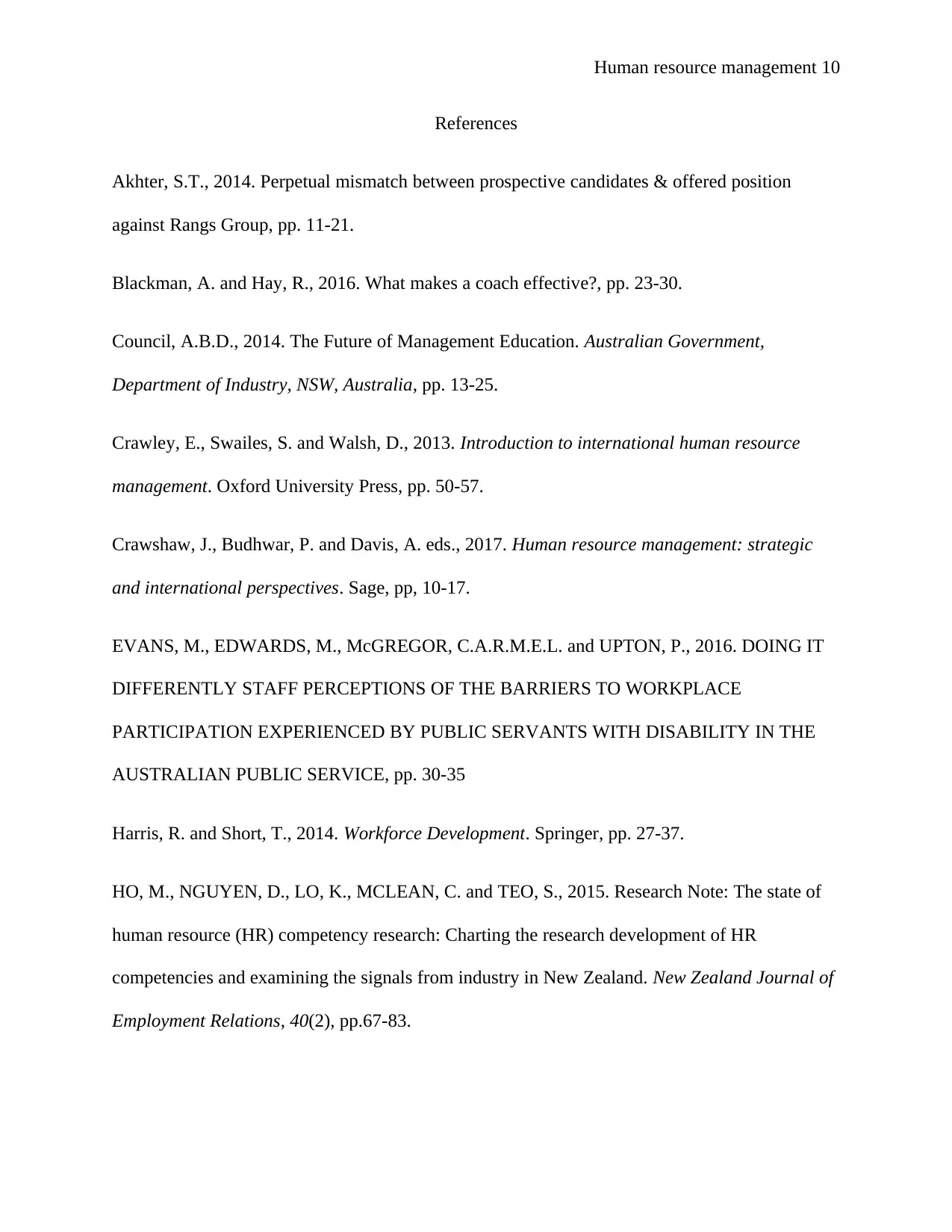
Human resource management 10
References
Akhter, S.T., 2014. Perpetual mismatch between prospective candidates & offered position
against Rangs Group, pp. 11-21.
Blackman, A. and Hay, R., 2016. What makes a coach effective?, pp. 23-30.
Council, A.B.D., 2014. The Future of Management Education. Australian Government,
Department of Industry, NSW, Australia, pp. 13-25.
Crawley, E., Swailes, S. and Walsh, D., 2013. Introduction to international human resource
management. Oxford University Press, pp. 50-57.
Crawshaw, J., Budhwar, P. and Davis, A. eds., 2017. Human resource management: strategic
and international perspectives. Sage, pp, 10-17.
EVANS, M., EDWARDS, M., McGREGOR, C.A.R.M.E.L. and UPTON, P., 2016. DOING IT
DIFFERENTLY STAFF PERCEPTIONS OF THE BARRIERS TO WORKPLACE
PARTICIPATION EXPERIENCED BY PUBLIC SERVANTS WITH DISABILITY IN THE
AUSTRALIAN PUBLIC SERVICE, pp. 30-35
Harris, R. and Short, T., 2014. Workforce Development. Springer, pp. 27-37.
HO, M., NGUYEN, D., LO, K., MCLEAN, C. and TEO, S., 2015. Research Note: The state of
human resource (HR) competency research: Charting the research development of HR
competencies and examining the signals from industry in New Zealand. New Zealand Journal of
Employment Relations, 40(2), pp.67-83.
References
Akhter, S.T., 2014. Perpetual mismatch between prospective candidates & offered position
against Rangs Group, pp. 11-21.
Blackman, A. and Hay, R., 2016. What makes a coach effective?, pp. 23-30.
Council, A.B.D., 2014. The Future of Management Education. Australian Government,
Department of Industry, NSW, Australia, pp. 13-25.
Crawley, E., Swailes, S. and Walsh, D., 2013. Introduction to international human resource
management. Oxford University Press, pp. 50-57.
Crawshaw, J., Budhwar, P. and Davis, A. eds., 2017. Human resource management: strategic
and international perspectives. Sage, pp, 10-17.
EVANS, M., EDWARDS, M., McGREGOR, C.A.R.M.E.L. and UPTON, P., 2016. DOING IT
DIFFERENTLY STAFF PERCEPTIONS OF THE BARRIERS TO WORKPLACE
PARTICIPATION EXPERIENCED BY PUBLIC SERVANTS WITH DISABILITY IN THE
AUSTRALIAN PUBLIC SERVICE, pp. 30-35
Harris, R. and Short, T., 2014. Workforce Development. Springer, pp. 27-37.
HO, M., NGUYEN, D., LO, K., MCLEAN, C. and TEO, S., 2015. Research Note: The state of
human resource (HR) competency research: Charting the research development of HR
competencies and examining the signals from industry in New Zealand. New Zealand Journal of
Employment Relations, 40(2), pp.67-83.
Paraphrase This Document
Need a fresh take? Get an instant paraphrase of this document with our AI Paraphraser
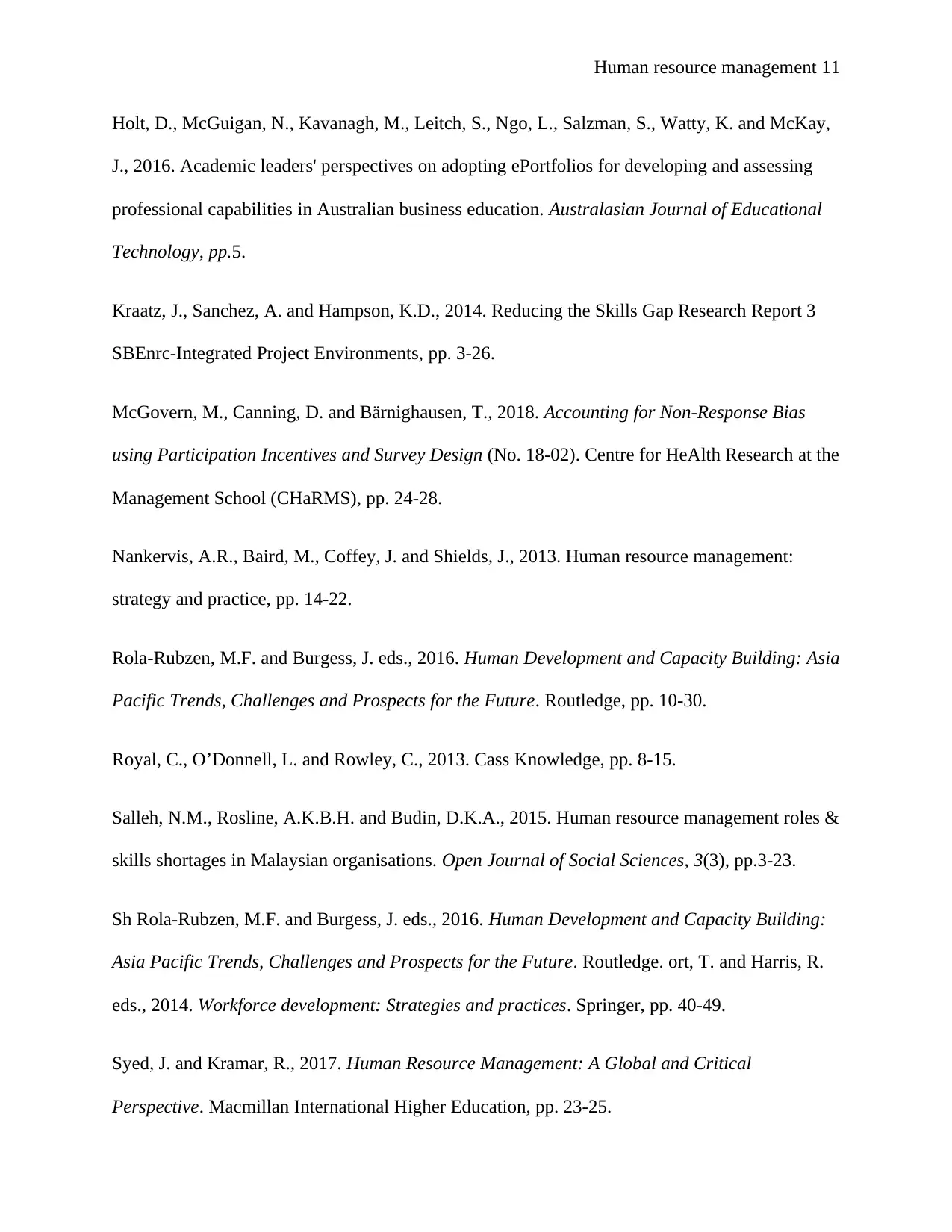
Human resource management 11
Holt, D., McGuigan, N., Kavanagh, M., Leitch, S., Ngo, L., Salzman, S., Watty, K. and McKay,
J., 2016. Academic leaders' perspectives on adopting ePortfolios for developing and assessing
professional capabilities in Australian business education. Australasian Journal of Educational
Technology, pp.5.
Kraatz, J., Sanchez, A. and Hampson, K.D., 2014. Reducing the Skills Gap Research Report 3
SBEnrc-Integrated Project Environments, pp. 3-26.
McGovern, M., Canning, D. and Bärnighausen, T., 2018. Accounting for Non-Response Bias
using Participation Incentives and Survey Design (No. 18-02). Centre for HeAlth Research at the
Management School (CHaRMS), pp. 24-28.
Nankervis, A.R., Baird, M., Coffey, J. and Shields, J., 2013. Human resource management:
strategy and practice, pp. 14-22.
Rola-Rubzen, M.F. and Burgess, J. eds., 2016. Human Development and Capacity Building: Asia
Pacific Trends, Challenges and Prospects for the Future. Routledge, pp. 10-30.
Royal, C., O’Donnell, L. and Rowley, C., 2013. Cass Knowledge, pp. 8-15.
Salleh, N.M., Rosline, A.K.B.H. and Budin, D.K.A., 2015. Human resource management roles &
skills shortages in Malaysian organisations. Open Journal of Social Sciences, 3(3), pp.3-23.
Sh Rola-Rubzen, M.F. and Burgess, J. eds., 2016. Human Development and Capacity Building:
Asia Pacific Trends, Challenges and Prospects for the Future. Routledge. ort, T. and Harris, R.
eds., 2014. Workforce development: Strategies and practices. Springer, pp. 40-49.
Syed, J. and Kramar, R., 2017. Human Resource Management: A Global and Critical
Perspective. Macmillan International Higher Education, pp. 23-25.
Holt, D., McGuigan, N., Kavanagh, M., Leitch, S., Ngo, L., Salzman, S., Watty, K. and McKay,
J., 2016. Academic leaders' perspectives on adopting ePortfolios for developing and assessing
professional capabilities in Australian business education. Australasian Journal of Educational
Technology, pp.5.
Kraatz, J., Sanchez, A. and Hampson, K.D., 2014. Reducing the Skills Gap Research Report 3
SBEnrc-Integrated Project Environments, pp. 3-26.
McGovern, M., Canning, D. and Bärnighausen, T., 2018. Accounting for Non-Response Bias
using Participation Incentives and Survey Design (No. 18-02). Centre for HeAlth Research at the
Management School (CHaRMS), pp. 24-28.
Nankervis, A.R., Baird, M., Coffey, J. and Shields, J., 2013. Human resource management:
strategy and practice, pp. 14-22.
Rola-Rubzen, M.F. and Burgess, J. eds., 2016. Human Development and Capacity Building: Asia
Pacific Trends, Challenges and Prospects for the Future. Routledge, pp. 10-30.
Royal, C., O’Donnell, L. and Rowley, C., 2013. Cass Knowledge, pp. 8-15.
Salleh, N.M., Rosline, A.K.B.H. and Budin, D.K.A., 2015. Human resource management roles &
skills shortages in Malaysian organisations. Open Journal of Social Sciences, 3(3), pp.3-23.
Sh Rola-Rubzen, M.F. and Burgess, J. eds., 2016. Human Development and Capacity Building:
Asia Pacific Trends, Challenges and Prospects for the Future. Routledge. ort, T. and Harris, R.
eds., 2014. Workforce development: Strategies and practices. Springer, pp. 40-49.
Syed, J. and Kramar, R., 2017. Human Resource Management: A Global and Critical
Perspective. Macmillan International Higher Education, pp. 23-25.
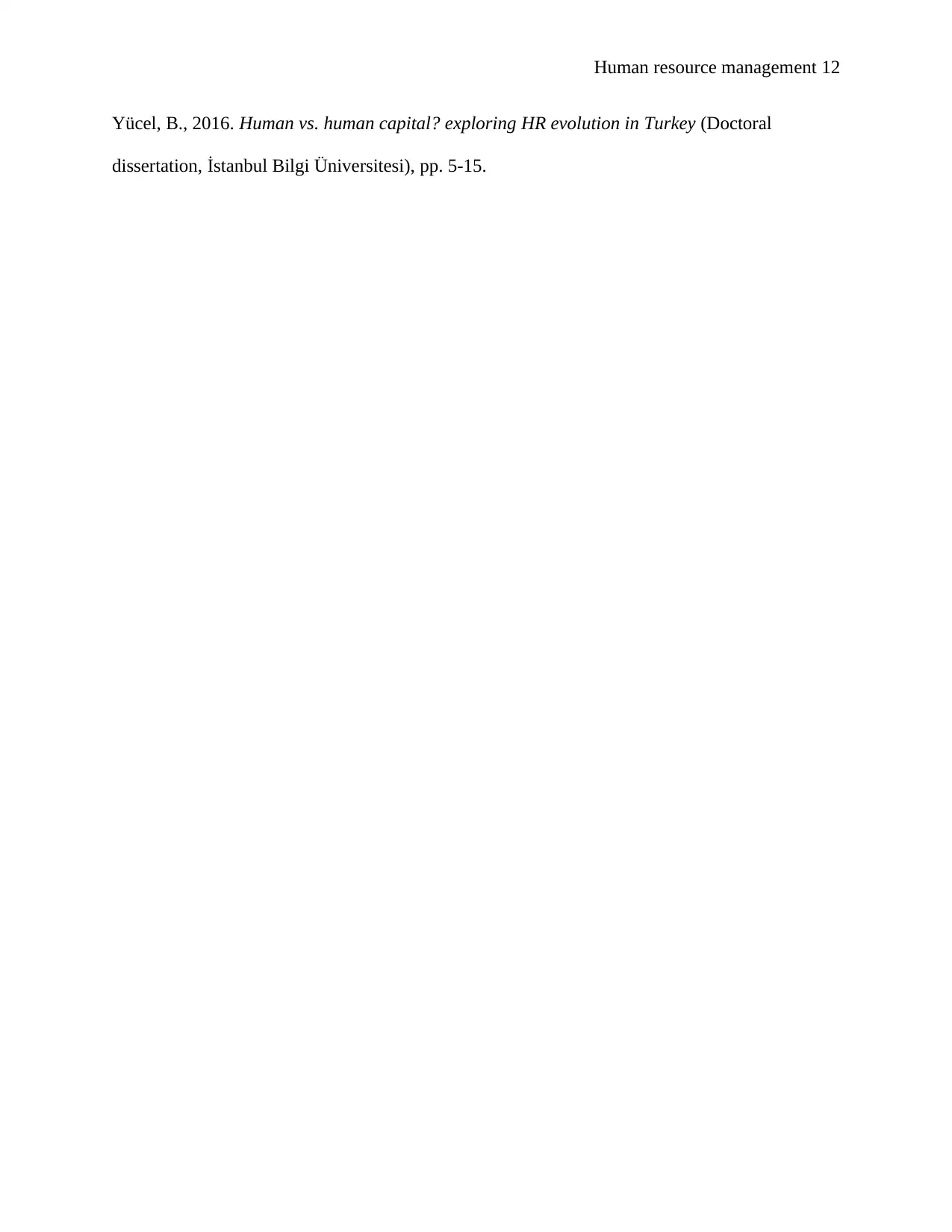
Human resource management 12
Yücel, B., 2016. Human vs. human capital? exploring HR evolution in Turkey (Doctoral
dissertation, İstanbul Bilgi Üniversitesi), pp. 5-15.
Yücel, B., 2016. Human vs. human capital? exploring HR evolution in Turkey (Doctoral
dissertation, İstanbul Bilgi Üniversitesi), pp. 5-15.
⊘ This is a preview!⊘
Do you want full access?
Subscribe today to unlock all pages.

Trusted by 1+ million students worldwide
1 out of 12
Related Documents
Your All-in-One AI-Powered Toolkit for Academic Success.
+13062052269
info@desklib.com
Available 24*7 on WhatsApp / Email
![[object Object]](/_next/static/media/star-bottom.7253800d.svg)
Unlock your academic potential
Copyright © 2020–2025 A2Z Services. All Rights Reserved. Developed and managed by ZUCOL.




